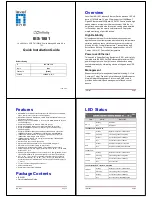
Data Sheet
© 2009 Cisco Systems, Inc. All rights reserved. This document is Cisco Public Information.
Page 10 of 20
●
Up to 64 aggregate or individual policers are available per Fast Ethernet or Gigabit Ethernet port.
Intelligent Power over Ethernet (PoE) Management
The Cisco Catalyst 3560 v2 series PoE models support Cisco IP phones, Aironet WLAN access points, as well as
any IEEE 802.3af compliant end device. These are some of the advanced PoE features available:
●
Cisco Discovery Protocol version 2 allows the Cisco Catalyst 3560 v2 Series Switch to negotiate a more
granular power setting when connecting to a Cisco powered device, such as IP phones or access points, than
what is provided by IEEE classification.
●
Per Port power consumption command allows customer to specify maximum power setting on an individual
port.
●
Per Port PoE Power Sensing measures actual power being drawn, enabling more intelligent control of
powered devices.
●
The PoE MIB provides proactive visibility into power usage and enables power policing and troubleshooting.
●
Link Layer Discovery Protocol (LLDP and LLDP-MED) adds support for IEEE 802.1AB link layer discovery
protocol for interoperability in multivendor networks. Switches exchange speed, duplex, and power settings
with end devices such as IP phones.
Management and Control Features
The Cisco Catalyst 3560 v2 series switches come with an extensive set of management and control features that
include:
●
Cisco IOS Software CLI support provides a common user interface and command set with all Cisco routers
and Cisco Catalyst desktop switches.
●
Cisco Discovery Protocol version 2 allows the Cisco Catalyst 3560 v2 Series Switch to negotiate a more
granular power setting when connecting to a Cisco powered device, such as IP phones or access points, than
what is provided by IEEE classification.
●
The PoE MIB provides proactive visibility into power usage and allows customers to set different power level
thresholds.
●
Switching Database Manager templates for access, routing, and VLAN deployment scenarios allow the
administrator to easily maximize memory allocation to the desired features based on deployment-specific
requirements.
●
Generic On-Line Diagnostics (GOLD) check the health of hardware components and verifies proper operation
of the system data and control plane at run time and boot time.
●
VLAN trunks can be created from any port, using either standards-based 802.1Q tagging or the Cisco Inter-
Switch Link (ISL) VLAN architecture.
●
Voice VLAN simplifies telephony installations by keeping voice traffic on a separate VLAN for easier
administration and troubleshooting.
●
Cisco VTP supports dynamic VLANs and dynamic trunk configuration across all switches.
●
Cisco Group Management Protocol server functions help enable a switch to serve as the Cisco Group
Management Protocol router for client switches. The IP Services license is required.
●
IGMPv3 snooping provides fast client joins and leaves of multicast streams and limits bandwidth-intensive
video traffic to only the requestors.
●
Remote SPAN (RSPAN) allows administrators to remotely monitor ports in a Layer 2 switch network from any
other switch in the same network.






































